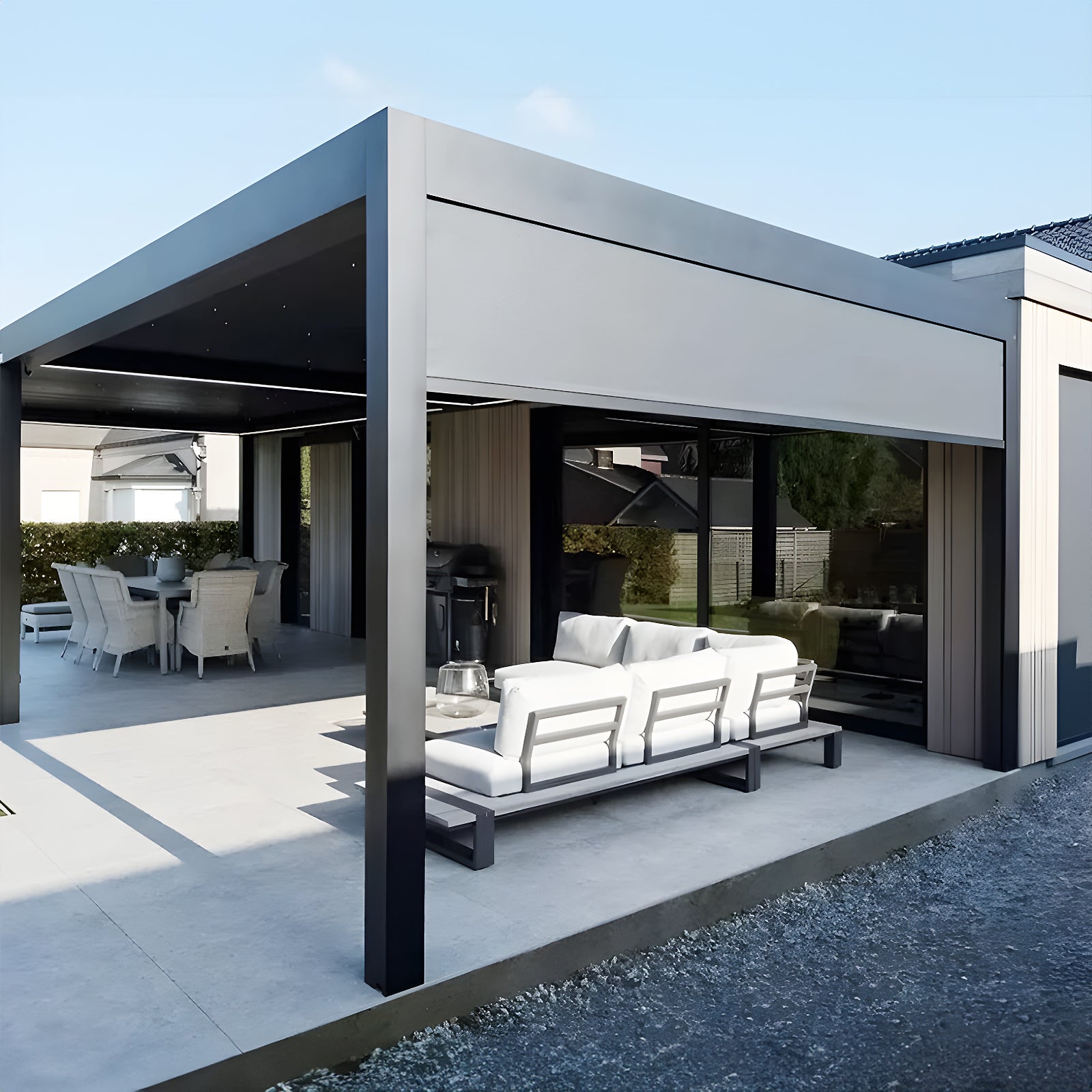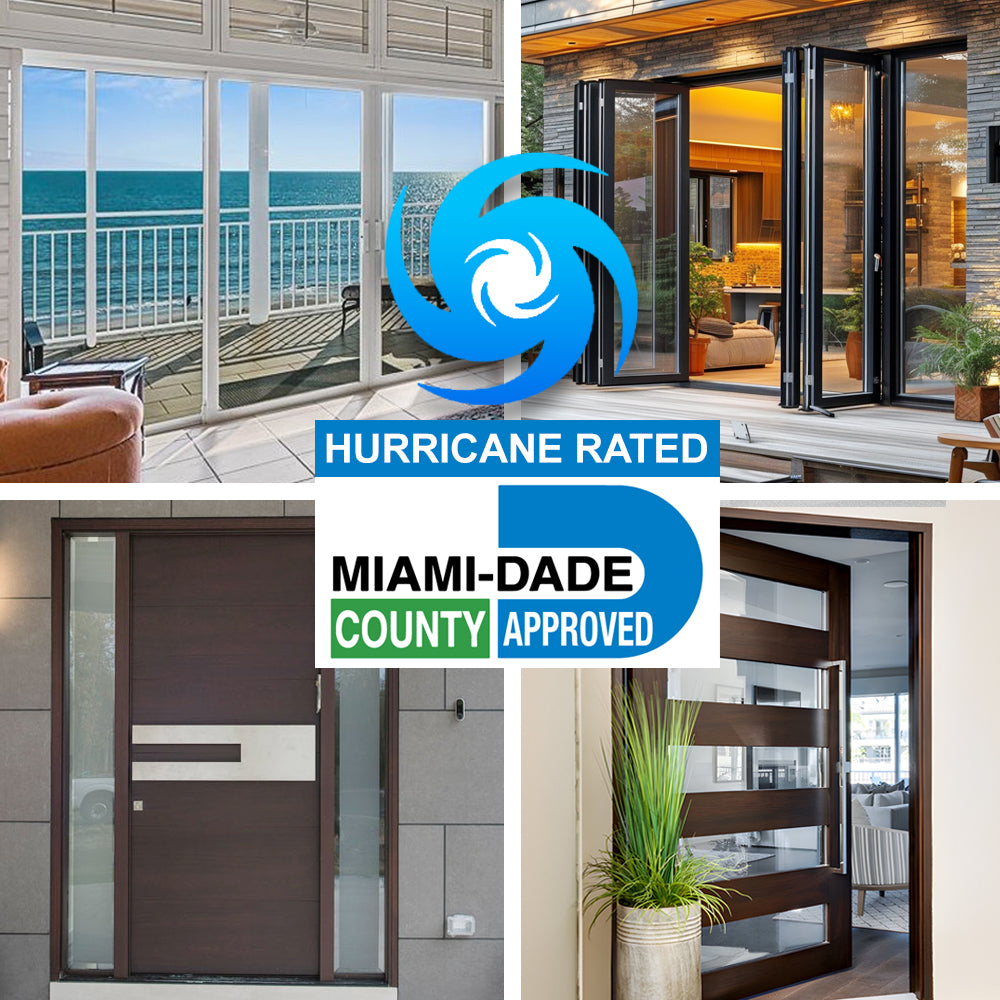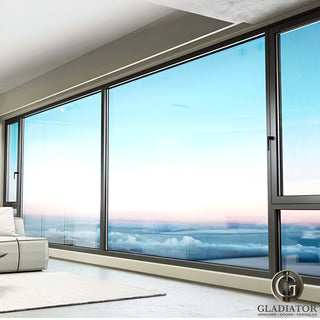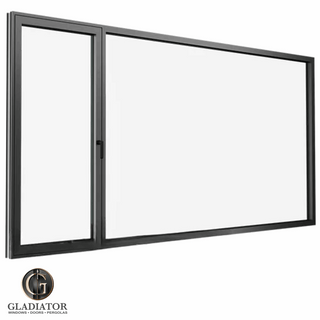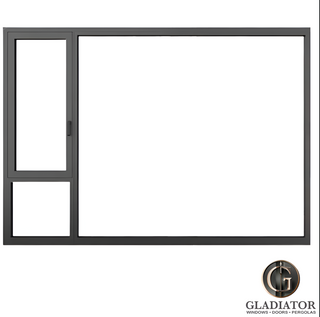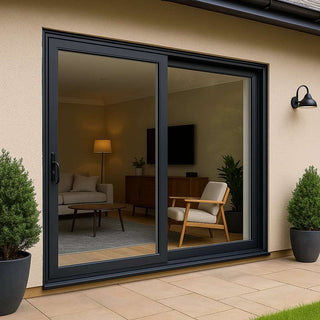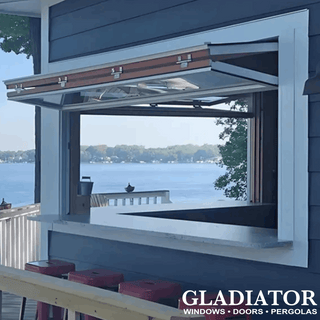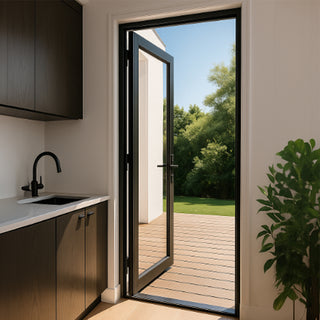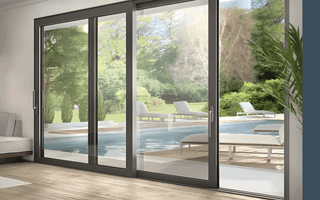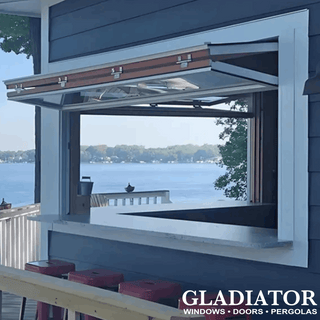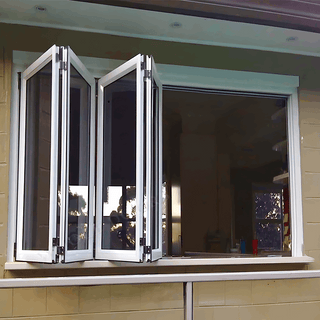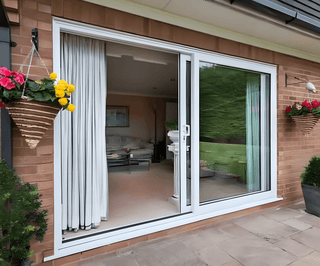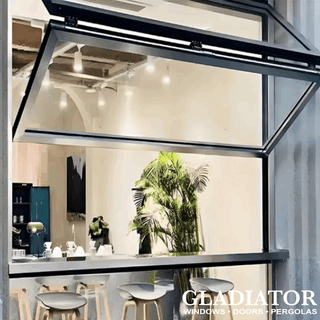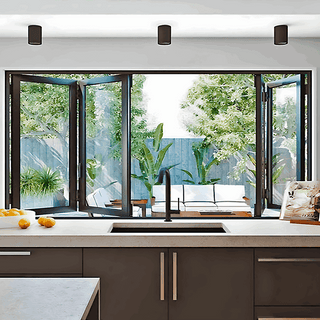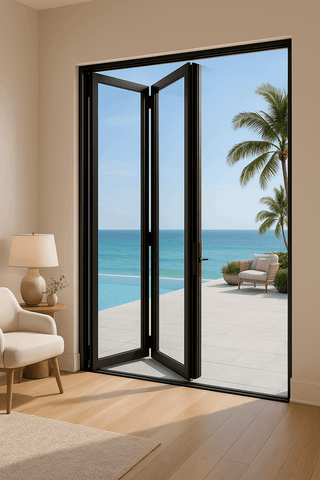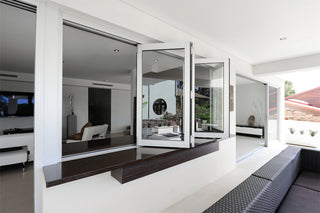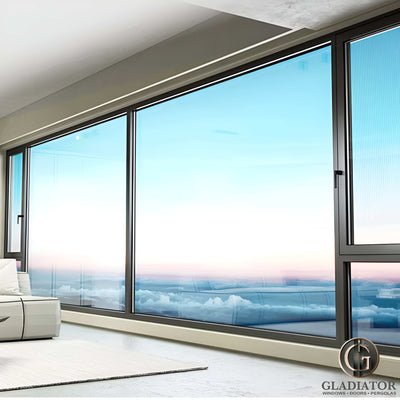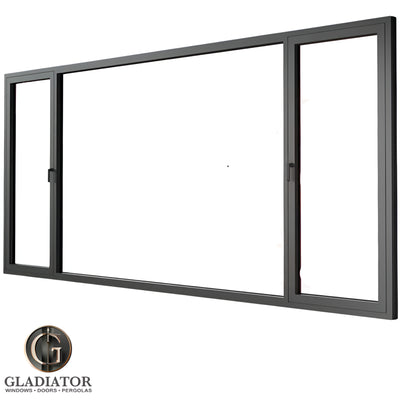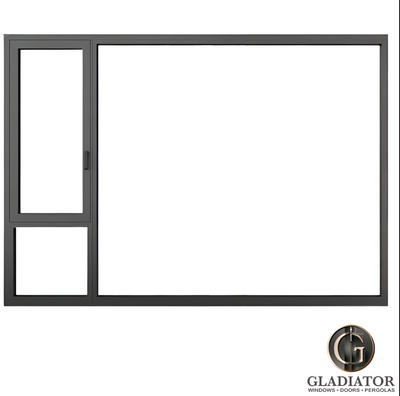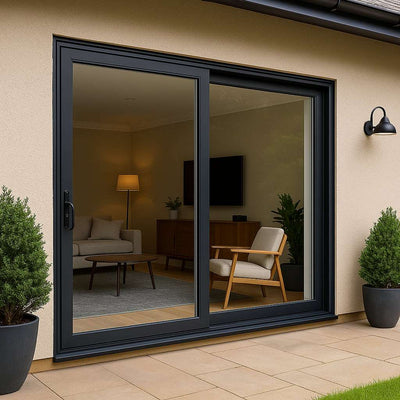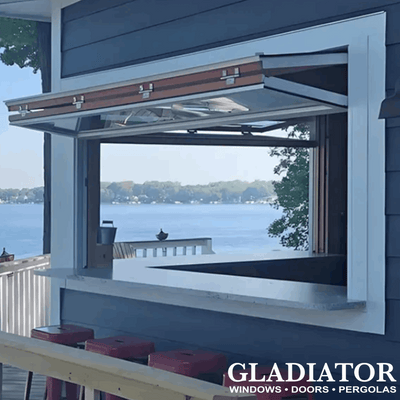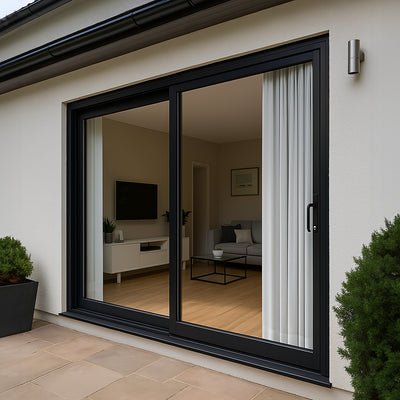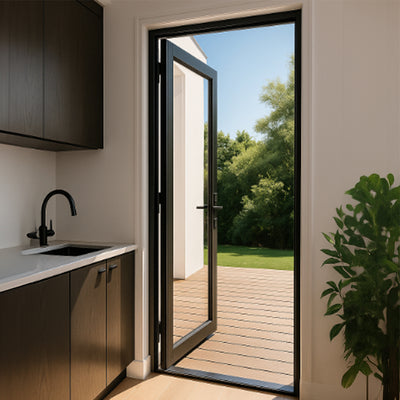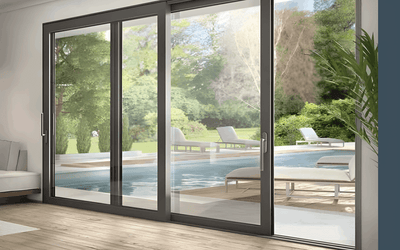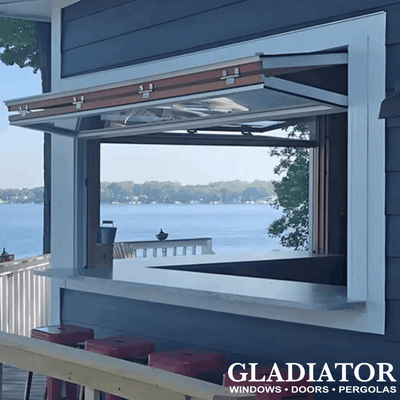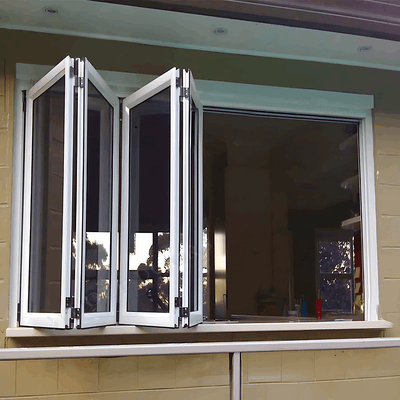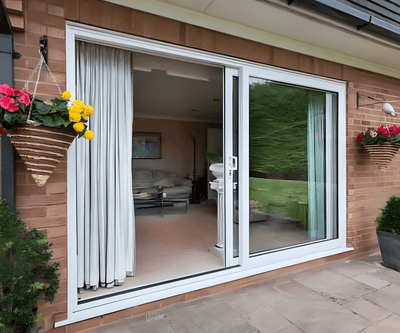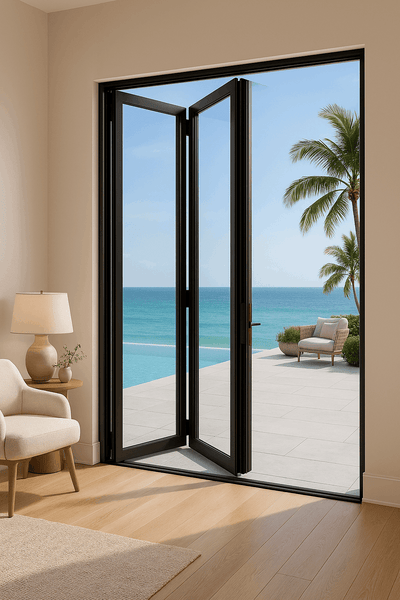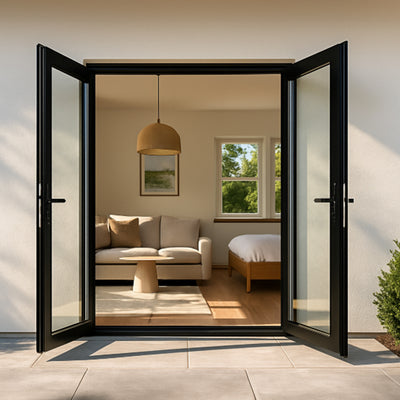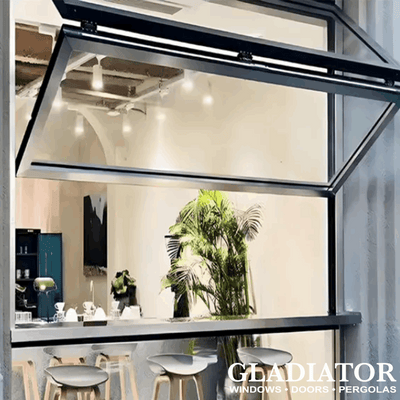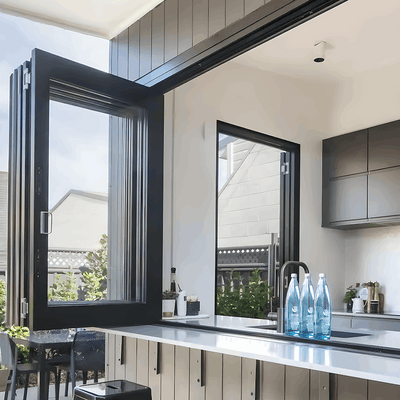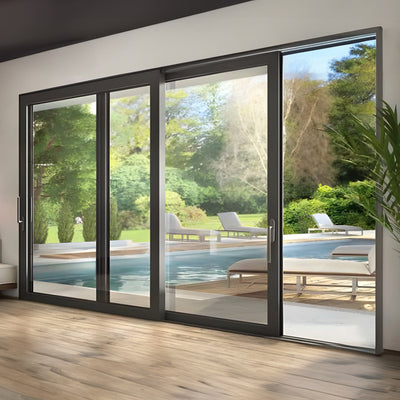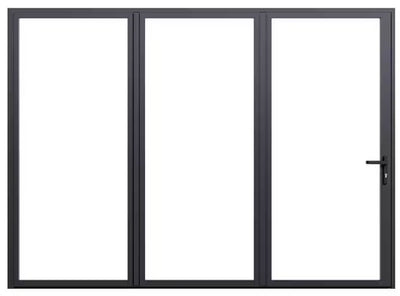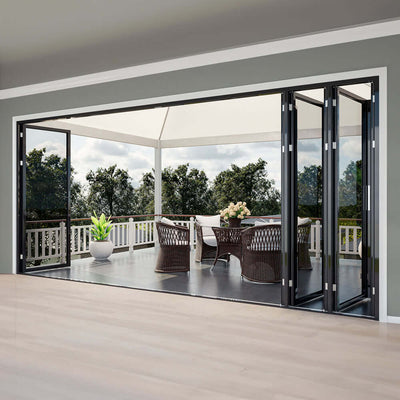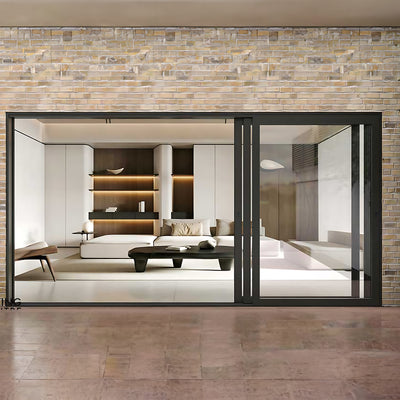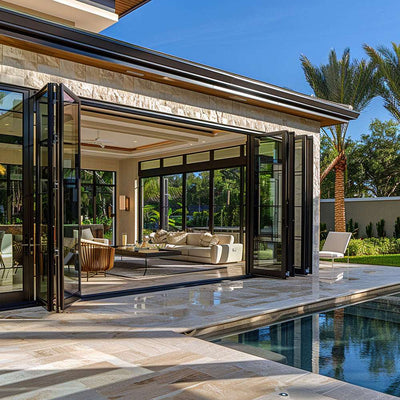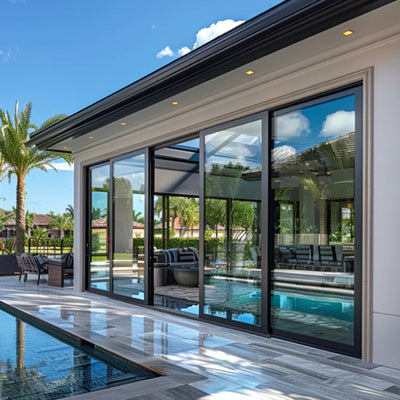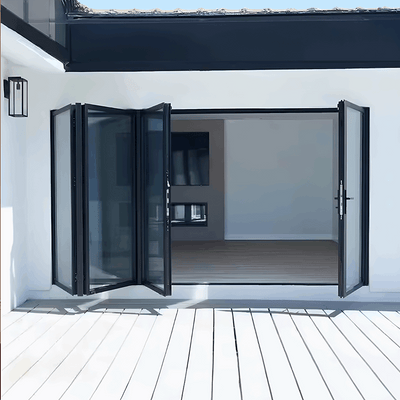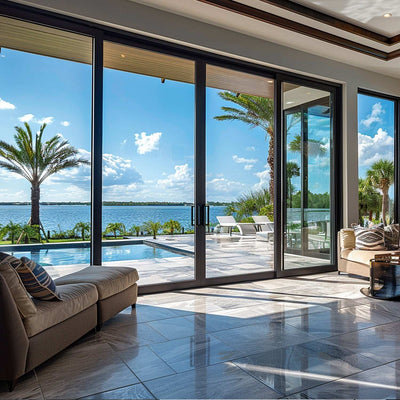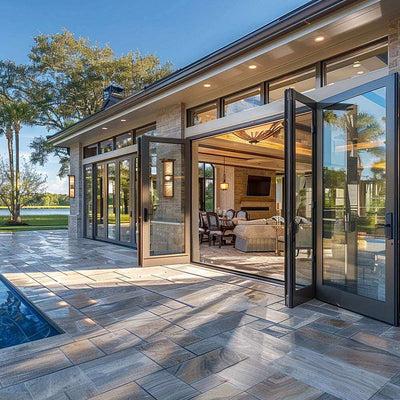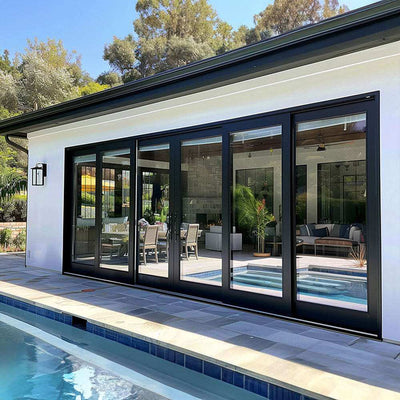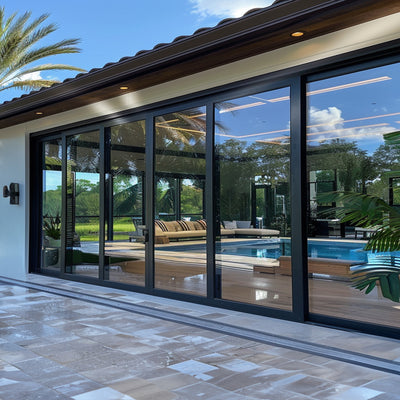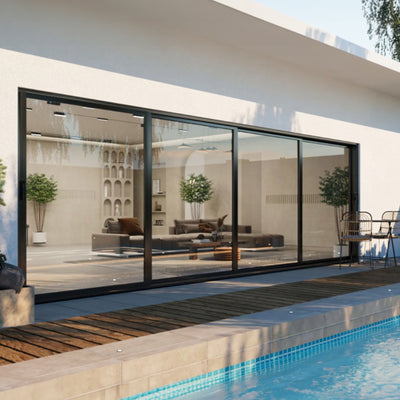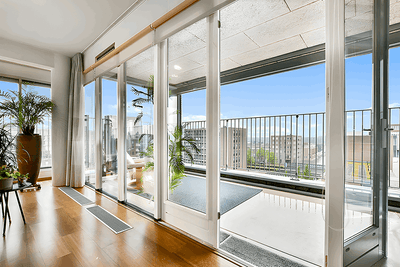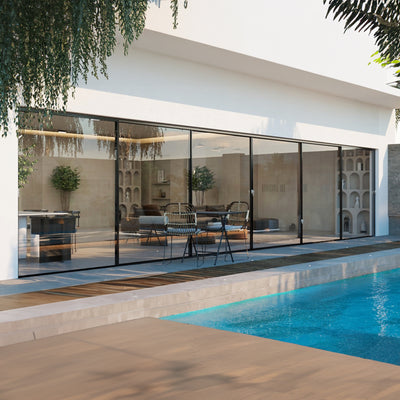The Bridge That Changes Everything: Understanding Thermal Breaks
Think about a standard, solid aluminum window frame. Aluminum is a great material—strong, light, and durable. But it’s also a fantastic conductor, which means it moves heat and cold very efficiently. This creates a thermal bridge, an easy path for the outside temperature to travel directly into your home, forcing your HVAC system to work overtime.
The Problem with a Direct Connection
Have you ever left a metal spoon in a hot cup of coffee? In just a few moments, the handle becomes warm to the touch. The metal acts as a highway for heat. A traditional aluminum window frame works the same way. During summer, it pulls in the sweltering heat. In winter, it leeches the warmth right out of your house, leading to higher energy bills and chilly drafts near your windows.
How a Thermal Break Interrupts the Flow
This is where the smart engineering of thermally broken aluminum windows comes in. A thermal break is a continuous barrier made from a material with low thermal conductivity that is placed between the interior and exterior parts of the aluminum frame. This simple addition completely severs the thermal bridge.
-
A Simple Analogy: Think of the sturdy plastic handle on a cast-iron pan. The pan can be sizzling hot on the stove, but the handle stays cool enough to touch. The thermal break acts as that protective handle for your home.
-
The Material: This insulating barrier is typically crafted from a reinforced polyamide or a specialized resin, both of which are poor conductors of temperature.
This design feature is a game-changer. By inserting a polyamide bar, a window can slow down the transfer of heat, cold, and even noise by up to 1,000 times compared to a non-broken frame. It’s no surprise that this technology is becoming more popular in modern construction. Discover more market insights on window technology.
The thermal break is what allows you to enjoy all the benefits of aluminum—its strength, sleek look, and longevity—without the major drawback of poor energy performance. It transforms the window from a simple pane of glass into a high-performance system. By stopping energy transfer in its tracks, thermally broken aluminum windows keep your home more comfortable and your energy bills lower. Learn more in our article about how thermally broken windows boost efficiency.
Inside The Technology: How Thermal Breaks Actually Work
Imagine holding a hot coffee mug on a cold day. If the mug is standard ceramic, you'll feel the heat transfer right to your hands. Now, imagine a double-walled, insulated travel mug—the heat stays inside, and your hands stay comfortable. The technology inside thermally broken aluminum windows works on the very same principle.
It creates a physical separation, or "break," between the exterior aluminum frame and the interior frame. This break is made from a material that resists temperature changes, effectively stopping outdoor heat or cold from passing through the metal and into your home.
How the Thermal Break Is Created
Manufacturers build this insulating barrier directly into the window frame using one of two primary methods. Both techniques result in a strong, unified frame with a built-in thermal shield.
-
Polyamide Strip Insertion: This process starts with two separate aluminum profiles—one for the inside and one for the outside. Each piece is designed with a channel that holds a rigid, insulating polyamide strip. The strip connects the two aluminum profiles, and the entire assembly is then crimped by rollers, locking the components together into a single, durable frame.
-
Pour and Debridge: This method begins with a single, wide aluminum extrusion that contains a pocket running along its length. Liquid polyurethane is poured into this pocket and left to cure. Once hardened, a saw cuts away the metal "bridge" at the bottom of the pocket, completely severing the connection between the inner and outer parts of the frame. The only thing holding the two sides together is the strong, insulating polyurethane.
This smart engineering is what makes these windows so effective at improving your home's energy efficiency.
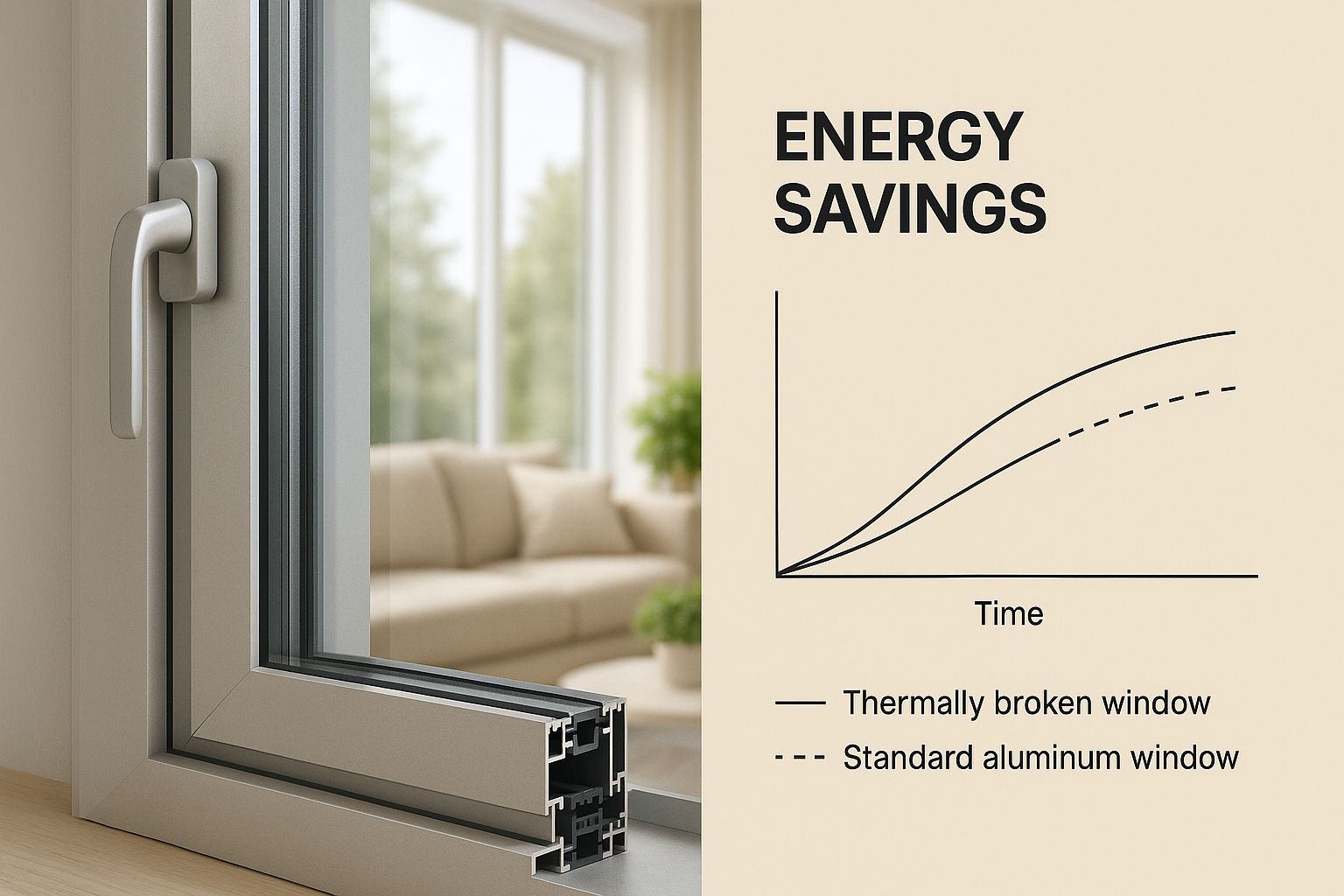
As you can see, the internal barrier prevents energy from escaping, which helps keep your home comfortable and your utility bills in check. Interrupting this thermal path is what dramatically elevates the performance of aluminum frames.
To help you understand the materials that make this possible, here’s a look at the two most common options used for thermal breaks.
Thermal Break Materials Comparison
Comparison of different thermal break materials used in aluminum window construction, showing their thermal conductivity, durability, and cost factors
| Material Type | Thermal Conductivity | Durability Rating | Cost Level | Best Use Case |
|---|---|---|---|---|
| Polyamide Strip | Very Low | Excellent | Moderate | Highly versatile for most window and door systems due to its structural strength. |
| Polyurethane Resin | Very Low | Excellent | Moderate | Ideal for "pour and debridge" systems, where it forms a seamless, powerful bond. |
As the table shows, both polyamide and polyurethane are top-performers in thermal insulation and durability. The choice often comes down to the specific manufacturing process and window design.
From Basic Barriers to Advanced Designs
Not all thermal breaks are designed the same way. While a standard system with a single, solid barrier is effective, more advanced designs take insulation to the next level.
High-performance thermally broken aluminum windows often use multi-chambered polyamide strips. Instead of a solid piece of plastic, these advanced strips contain several hollow pockets. This design traps air inside the thermal break itself, creating another layer of insulation—much like the air gap in a double-pane glass unit.
The wider the thermal break and the more complex its chambers, the better the window is at resisting temperature transfer. This superior performance is measured by a window's U-factor, and premium windows can achieve U-factors as low as 0.15, which is far better than what most energy codes require. Ultimately, the quality of the thermal break, paired with high-performance glass, is what defines a window's final energy rating.
To see how this technology fits into the bigger picture of home energy efficiency, check out our guide on energy-efficient windows and their benefits.
Real Savings From Real Homes: What You Can Actually Expect
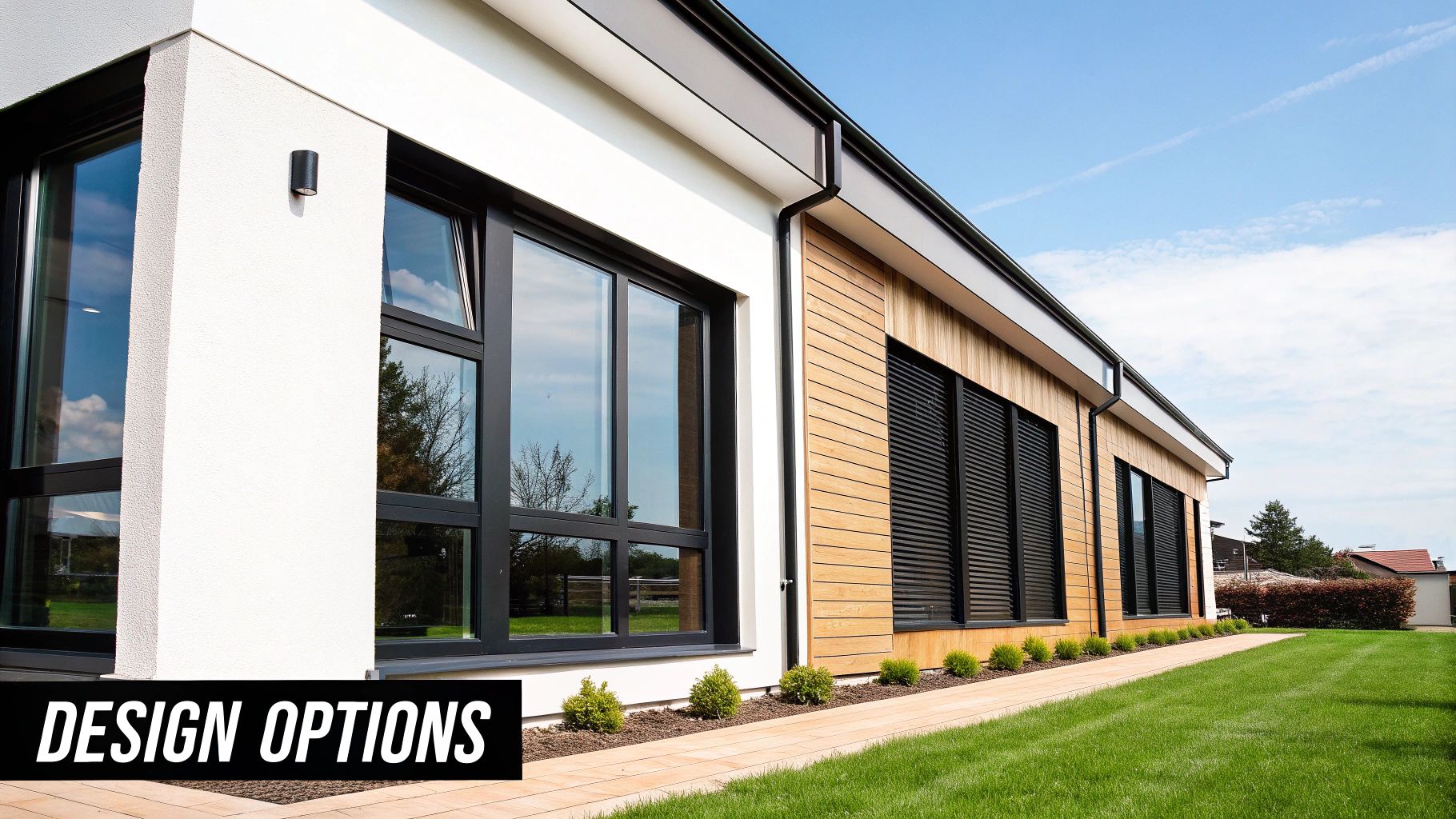 While the science behind thermal breaks is fascinating, let's talk about what really matters: the money you can save. Switching to thermally broken aluminum windows is a direct investment in your wallet, but the exact return isn't one-size-fits-all. The final number on your monthly energy bill depends on a few key variables in your home.
While the science behind thermal breaks is fascinating, let's talk about what really matters: the money you can save. Switching to thermally broken aluminum windows is a direct investment in your wallet, but the exact return isn't one-size-fits-all. The final number on your monthly energy bill depends on a few key variables in your home.
Think of it like upgrading your car. The fuel savings you'll see depend on what you were driving before. Swapping a gas-guzzler for a hybrid will yield dramatic results, while upgrading from an already efficient sedan will show a more modest change. Your window savings work the same way—it all comes down to your starting point.
Calculating Your Potential Return on Investment
Your actual savings are shaped by three main things: your local climate, the size of your house, and the condition of your current windows. A homeowner in a scorching climate like Las Vegas will see huge savings on air conditioning. Someone in a frigid northern region will notice a big drop in their heating costs. The greater the temperature difference between inside and out, the more your old windows are working against you.
- Existing Windows: The most significant savings come from replacing old, single-pane glass or standard non-broken aluminum frames. The performance difference is night and day.
- Home Size: A larger home with more windows has more surface area for energy to escape. This means the potential for savings with an upgrade is also much greater.
By looking at these factors, you can get a clear idea of what to expect. Many people find that the investment pays for itself much faster than they imagined.
More Than Just Lower Bills: Added Financial Perks
The financial upside of thermally broken aluminum windows goes beyond just a smaller energy bill. A major benefit is that your HVAC system gets a much-needed break. By creating a more stable indoor temperature, these windows help your heating and cooling equipment run less often and more effectively. This leads to:
- Lower maintenance costs over the life of your HVAC system.
- A longer lifespan for your expensive heating and cooling equipment.
On top of that, high-performance windows are a powerful selling point that can increase your property's value. Today's homebuyers are smart about energy efficiency, and they actively seek out homes with modern, cost-saving features. This upgrade isn't just for you; it's an asset that adds real value to your home.
Understanding the Payback Period
While the initial cost of these advanced windows is higher than standard options, the return on your investment comes from multiple sources. The combination of direct energy savings, less wear and tear on your HVAC system, and a boost in home value makes a strong financial case. Many homeowners also say the immediate improvement in comfort—no more drafts or hot spots near the glass—is a priceless benefit on its own.
The payback timeline varies, but it's built on both monthly savings and long-term equity. If you want to learn more about the wider benefits of window upgrades, you can explore our guide on upgrading your home with energy-efficient windows.
Why The Construction World Is Going Thermal: Market Momentum
The growing presence of thermally broken aluminum windows is much more than a passing design trend; it signals a deep-seated change in how we build. This market momentum isn't a result of slick marketing campaigns but is powered by real-world, practical needs. From small architectural studios to major construction developers, these high-performance windows are quickly becoming the new normal for projects that demand both efficiency and modern style.
The Core Drivers of Adoption
This industry-wide shift is being pushed forward by two major forces. The first and most significant is the constant tightening of building energy codes. As cities and states demand more efficient buildings to reduce energy consumption, standard non-broken aluminum frames are fast becoming a thing of the past. Thermally broken aluminum windows provide a clean and effective way for builders to meet these tough U-factor and SHGC standards without giving up their design vision. They make it possible to have the large, slim-profile glass walls that are a hallmark of modern design while ensuring excellent thermal management.
At the same time, what homeowners want has changed. Today's buyers are well-informed about sustainability and the long-term costs of running a home. They are specifically looking for features that lower their carbon footprint and bring real savings each month. The appeal of a comfortable, draft-free home paired with lower energy bills makes these windows a very compelling feature. If you are considering the investment, our detailed breakdown of energy-efficient window costs can offer some valuable perspective.
Impressive Growth and a Look Ahead
The financial numbers back up this story in a big way. The market's growth is tied to the expansion of the entire aluminum doors and windows sector, which is expected to grow from $67.28 billion in 2024 to $71.58 billion in 2025 at a compound annual growth rate of 6.4%. This increase is directly linked to more investment in construction and a worldwide emphasis on sustainable building, where thermally broken technology is a key component. You can read more about these market trends to see the full picture.
This growth is also sparking new developments. Researchers are creating new composite materials for thermal barriers and developing advanced multi-chambered frame designs that are elevating performance to levels once only seen in ultra-efficient Passive House projects. As the building industry aims for net-zero energy homes, these advancements become essential. Many homeowners wonder if the upgrade is worth it beyond the immediate comfort, and the answer is a firm yes. These windows are a proven method to increase home value and improve curb appeal, offering a solid return on investment.
The Ultimate Performance Showdown: Thermal Vs Traditional
When you're choosing new windows, the options can feel overwhelming. Let's cut through the noise and put thermally broken aluminum windows side-by-side with their traditional counterparts like standard aluminum, vinyl, and wood. This isn't just about looks; it's about finding the perfect fit for your climate, budget, and how you live in your home.
A Head-to-Head Thermal Battle
Think of a standard aluminum window frame like a metal spoon in a hot cup of coffee. The heat travels right up the spoon, and that's exactly what happens with your home's energy. This "thermal bridge" lets summer heat pour in and winter warmth escape, leading to a poor U-Factor—the measurement of heat loss where lower is better.
Now, imagine a small, insulated grip on that spoon. That's the "thermal break." In thermally broken aluminum windows, a strip of less conductive material (like polyamide) is placed inside the frame, completely separating the interior and exterior metal pieces. This simple but powerful barrier stops that energy superhighway cold.
The result is a huge leap in performance. These windows can achieve remarkable U-Factor ratings, sometimes dipping as low as 0.17 or even 0.15. This puts them in the same league as top-tier fiberglass and makes them a smart choice for any climate, from scorching summers to freezing winters.
Beyond the Break: A Full Material Comparison
While stopping heat transfer is a game-changer, it's not the whole story. The material you choose for your window frames affects everything from weekend maintenance chores to how long they'll last. To give you a clear, head-to-head comparison of thermally broken aluminum windows against traditional aluminum, vinyl, wood, and fiberglass windows across key performance metrics, we've put together the table below.
Window Material Performance Comparison
| Window Material | U-Factor | Maintenance Level | Lifespan | Cost Range | Best Climate |
|---|---|---|---|---|---|
| Thermally Broken Aluminum | Excellent (0.15-0.25) | Low | 45+ Years | High | All Climates |
| Traditional Aluminum | Poor (>0.60) | Low | 45+ Years | Moderate | Mild / Warm |
| Vinyl | Good (0.25-0.35) | Low | 20-30 Years | Low-Moderate | Moderate |
| Wood | Good (0.25-0.35) | High | 30+ Years | High | All (with care) |
| Fiberglass | Excellent (0.15-0.25) | Low | 50+ Years | Very High | All Climates |
As the table shows, while thermally broken aluminum has a higher upfront cost, its excellent U-Factor, long lifespan, and low maintenance put it on par with fiberglass as a top performer for durability and efficiency. Choosing the right material is just one step; for a complete overview of the process from start to finish, you can explore our ultimate window replacement guide.
The Total Cost of Ownership
The sticker price is just the beginning of the story. To understand the true value, you have to consider the total cost of ownership over the life of the windows. A less expensive option might cost you more in the long run in terms of maintenance and replacement.
For instance, wood windows are beautiful but demand regular painting or staining to fend off rot and decay—a commitment of both time and money. Vinyl is a low-maintenance favorite, but it can become brittle over time and may lack the structural strength needed for very large, modern window openings.
This is where aluminum's inherent strength makes a difference. It won't warp in the sun, rot in the rain, or weaken from UV exposure. That makes it an outstanding choice for demanding environments, whether you're dealing with desert heat or salty coastal air. When exploring these high-performance options, you might speak directly with sales representatives. Knowing a bit about common door-to-door sales techniques can make you a more confident and prepared buyer.
In the end, thermally broken aluminum windows strike a fantastic balance. You get the clean lines, slim profiles, and incredible strength of aluminum, but with energy efficiency that competes with the very best materials on the market. It’s a combination that delivers on style, long-term durability, and real-world energy savings with very little maintenance required. This blend of practicality and performance is precisely why they have become a go-to choice for homeowners and builders aiming for a modern, efficient home.
Smart Shopping: Separating Premium From Pretenders
Now that you know the performance benefits, it's time to talk about choosing the right windows. Not all thermally broken aluminum windows are made the same, and the market includes everything from top-tier products to cheap imitations. Knowing what to look for helps you see past the sales pitch and focus on the details that provide real, lasting value for your home.

Decoding the Numbers That Matter
The simplest way to compare windows is to check their certified ratings, much like reading a nutrition label. The most critical number is the U-Factor, which tells you how well the window stops heat from escaping. Just think of it like a golf score—the lower the number, the better the window's insulating power. A basic, older aluminum window might have a U-Factor above 0.60, whereas high-quality thermally broken aluminum windows can achieve ratings as low as 0.15.
Another important rating is the Solar Heat Gain Coefficient (SHGC), which shows how much of the sun's heat the window blocks. A lower SHGC is great for hotter climates because it helps lower your air conditioning bills. Always check for the official National Fenestration Rating Council (NFRC) label on the window, which confirms that these performance numbers have been independently tested and verified.
Beyond the Frame: What Else to Inspect
A high-performance frame is just the starting point; a premium window is a complete system. Pairing a high-tech frame with basic glass is like putting budget tires on a sports car—you won’t get the performance you paid for. Pay close attention to these key components:
- The Glazing Package: This is the glass assembly. Look for dual or triple-pane glass that is filled with an inert gas like argon. When combined with a Low-E (low-emissivity) coating, this package works alongside the thermal break to deliver maximum energy efficiency.
- Hardware Quality: The handles, locks, and cranks are the parts you'll touch every day. Flimsy hardware not only feels cheap but can also fail over time, creating security and operational problems. Quality windows feature solid, smoothly operating hardware built to last.
- Construction Details: The small details often reveal the true quality. Check the corners of the window frame; they should be clean and seamless. The paint or finish should be even and durable, and the weatherstripping should be thick and fully integrated to create a tight seal against air and water.
Asking the Right Questions and Spotting Red Flags
When you start gathering quotes, your research becomes your most valuable tool. A good contractor will be happy to answer specific questions and provide clear information. Being ready to ask the right questions helps you determine their expertise and the quality of their products.
Here are a few essential questions to ask any potential installer or manufacturer:
- What are the exact U-Factor and SHGC for the windows you are proposing?
- Can you walk me through the warranty? What does it cover for the glass, frame, and installation labor?
- What brand of hardware do you use, and what are its main features?
- What type of Low-E coating is used in the glass package?
If you are new to homeownership, understanding the broader context of home improvement can be very helpful. These first time home buyer tips offer great advice that can make you a more informed consumer for any project.
Finally, trust your instincts. Be cautious of high-pressure sales tactics, vague answers about performance, or prices that seem too good to be true. A premium product is backed by transparent data, a strong warranty, and a company that is proud to stand behind its engineering. Being a smart shopper ensures you receive the comfort, energy savings, and durability that thermally broken aluminum windows are designed to deliver.
Installation Excellence And Long-Term Success
Choosing high-performance thermally broken aluminum windows is a fantastic first step toward a comfortable, energy-smart home. But the quality designed into the window frame is only half the battle. How that window is installed makes all the difference, determining whether you enjoy its full benefits or end up with drafts and high energy bills.
The Critical Role of Professional Installation
A poor installation can wipe out all the benefits you paid for. A proper fit isn't just about sliding the window into the opening; it’s about creating a perfect, weatherproof seal. This involves expert flashing and sealing to block air and water leaks that cause drafts and expensive damage.
Think of it like a race car. You can have the most powerful engine, but if the tires are wobbly, you're not winning any races. A flawless installation ensures your window and wall work together as a single, efficient system, protecting your home and your wallet.
An improper fit can even create new problems. It can form a thermal bridge, which is like a secret escape route for your home’s heat. This diagram shows how heat can find a path of least resistance to bypass a wall's insulation.
Gaps around a poorly installed window act just like that, letting energy flow out and defeating the purpose of the thermally broken frame.
Long-Term Care and Simple Maintenance
The good news is that aluminum is incredibly durable and low-maintenance. Keeping your thermally broken aluminum windows working perfectly for decades only takes a little bit of attention now and then.
A few simple habits will go a long way:
- Clean Regularly: A quick wipe-down of the glass and frames with mild soap and water is all it takes to prevent dirt and grime from building up.
- Check Weep Holes: These small holes at the bottom of the frame are essential for drainage. Make sure they’re clear of debris so water can get out.
- Inspect Seals: Give the weatherstripping a quick look every so often. If you see any cracking or peeling, it might be time for a repair to keep your airtight seal intact.
Troubleshooting and Performance Checks
Even with the best windows, it’s smart to keep an eye on how they're performing. If you think something is off, a couple of easy checks can help you pinpoint the issue.
On a windy day, run your hand along the inside edge of the window. If you feel a draft, you’ve likely found a leak. Another key sign is condensation. If you see fog or moisture between the two panes of glass (not on the surface inside your room), it usually means the seal has failed.
While cleaning out a blocked weep hole is a simple fix you can do yourself, things like a broken seal or damaged hardware are jobs for a pro. Catching these small issues early can save you from bigger problems later on.
A high-quality window is only as good as its installation. Getting it right from day one is the key to unlocking years of energy savings, comfort, and satisfaction. When you’re ready to pair a superior product with the expert installation it deserves, explore the custom-made thermally broken aluminum windows available at Gladiator Window and Doors.










